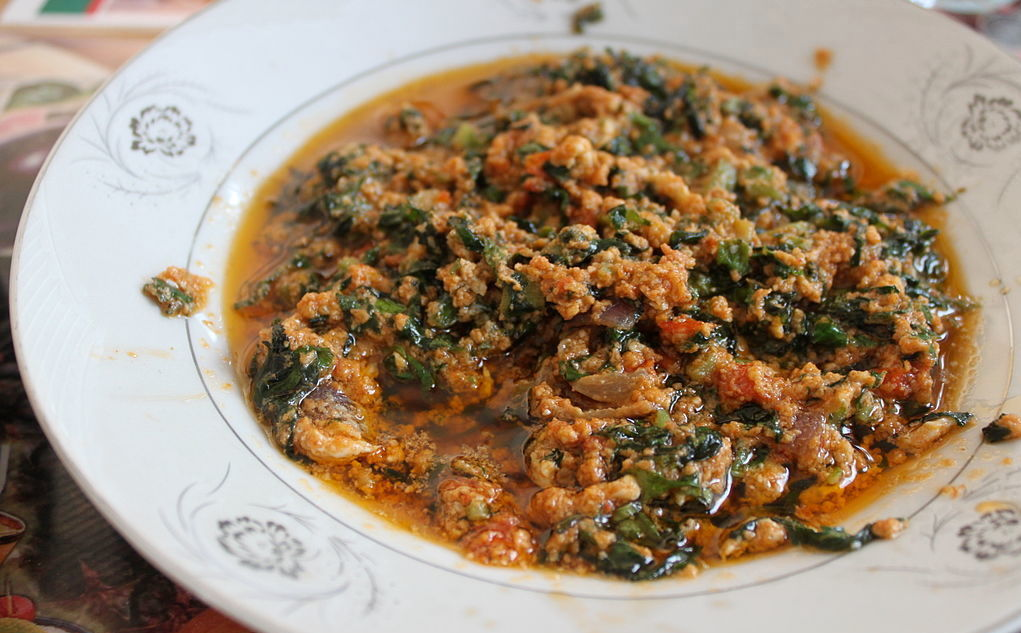Ghana's Kontomire Stew Stirs The Soul
I'm lucky. I live in a big city that offers an unending supply of different African cuisines. I can eat from one end of the continent to the other, sampling Moroccan, Ethiopian, Nigerian, Senegalese, and Ghanian dishes. So when I visited Ghana, I was prepared to be dazzled by the West African country's culinary riches and I was not disappointed.
As the first African nation to achieve independence from a European colonizer in 1957, Ghana boasts a long history of African pride and cultural preservation. All over the country, from the rural towns to the cities, displays of Ghanaian traditions, symbols, and attire were prominent. This also affected the preparation of the food, which centered on fresh local produce, and accents like banana leaves, edible flowers, and calabash shells were prominent.
Stepping into the busy streets of Accra, the nation's capital, the first thing that I noticed was the warmth of the people. They smiled and offered akwaaba! (welcome) as I moved through the markets, restaurants, and parks. Whether I was watching skilled weavers demonstrate their artistry with brightly colored and patterned kente cloth, or greeting the local chiefs and traditional rulers with a bow at their gleaming white palace, Ghanaians placed a lot of importance on making me feel at home. This sense of hospitality was especially apparent when I visited a variety of restaurants. I ate a lot, and I was overstuffed with food every day of my travels. There were regional variants and a lot of Asian/European fusion dishes—think Accra pizza with jollof-inspired ingredients—but I discovered my favorite was the savory palava sauce or kontomire stew, a scrumptious mix of cocoyam leaves, bitter melon seeds, and fish. It took days to discover my favorite dish, however; I gobbled lots of other dishes in Ghana along the way.
The first restaurant I visited was Ike's Cafe and Grill in Kumasi, the capital of the Ashanti region about 150 miles northwest of Accra. Because of where the country is situated on the Gulf of Guinea, fish plays a major part in Ghanian cuisine. At Ike's, large fish tanks and a lagoon, ringed by our thatched-roof-covered outdoor dining tables, served as locations to select your personal meal. I ordered snapper with banku, a fermented corn and cassava dough rolled into balls. Eating the perfectly grilled and seasoned fish under the stars with Afrobeats playing in the background made for a magical experience. In Accra, I ate jollof rice with chicken and kelewele, fried plantains covered with ginger, red pepper, and salt. The crunchy, spicy exterior and soft interior of the plantains paired well with the chicken and rice. If you're familiar with Africa's Jollof Rice Wars, you know that each country holds its version as sacred, but I forgot and made the mistake of mentioning that Senegal's is my favorite, since Ghana's jollof is less spicy. Gathering from the looks that the otherwise friendly locals shot me, I'm fortunate that I was allowed to remain in the country. I also sampled the popular palm nut soup, abenkwan, so heavy with fish and layers of peppers, tomatoes, okra, and spices that I almost fell asleep at the table.

It was in the salt-kissed fishing village of Cape Coast in central Ghana that I discovered the classic palava sauce, also known as kontomire stew. Cape Coast is also the site of Cape Coast Castle, which operated as the largest slave-trading center in West Africa throughout the 18th century. Suffice it to say, after tracing my forebearers' steps in the fort's dark dungeons, I was an emotional wreck when I sat down at a local cafe overlooking a beach. The cafe owners, a group of Black American expats, had gathered to welcome me and my group, and though I was in no mood to eat, in Ghana, refusing a meal is a deep insult. The emerald green stew was placed before me and I tasted a little. The flavor was complex and slightly spicy with a building intensity. The cocoyam leaves tasted a little like tender mustard greens with a nutty texture from the bitter melon seeds. Pounded yam was served on the side, to be dipped into the stew to absorb the spice and sop up the flavorful sauce.
Kontomire stew was earthy and comforting, with an addictive richness. I scooped up more and gradually felt better. My hosts explained that the stew is reportedly a result of the meeting of Europeans and locals from the town of Elmina, which was the site of the first Western settlement. Palava or palaver is slang for a fuss or unproductive debate. The traditional recipe calls for a mix of meat, fish, palm oil, and enough peppers and spices that would not seem to agree with each other, but blended together, they create one of Ghana's most beloved dishes. There, in the shadow of a reminder of the most egregious part of human history, I found a local delicacy that helped soothe me. I can't say if any other dish would have had such a profound effect, but kontomire stew managed it, and it was unforgettable.
